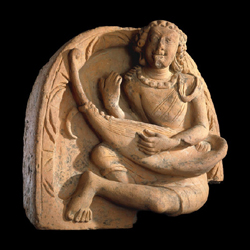
Gupta period, 5th century AD
Terra cotta
From an early Hindu temple in central India
Height: 11 inches
OA 1969.12-17.1
Image courtesy of the British Museum (copyright reserved)
The Gupta period saw a rise in royal patronage of Hinduism, which supported the construction of a large number of temples. As noted by experts at the British Museum, two distinct types of Hindu temples had developed by the fifth century. The first type was constructed of stone, and was usually of relatively small scale. The second type was built with brick and decorated with terra-cotta tiles and sculpted figures, such as this example from the British Museum collection.
Though this figure originally decorated a Hindu temple, similar motifs are also found on Buddhist structures. In fact, much of the secondary imagery used to decorate worship halls was shared by the two traditions, and figures of dancers, musicians and other entertainers were frequently depicted on both Buddhist and Hindu temples and shrines.
It is interesting to note the similarity between musical instruments reproduced in Gupta-era art and those found in lands located along the silk routes. It is probable that the oud of the Middle East, the dombra of Central Asia, and the pipa of China all share the same prototype with the lute-like instrument played by this musician.